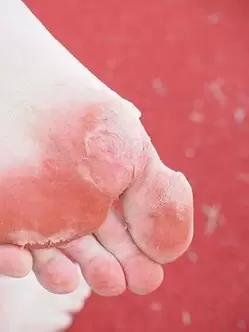Foot mycosis is the most common fungal infection of the skin today. Foot mycosis is divided into three main types, also called foot mycosis. And each type is located on a different part of the foot and looks different.

How can you get foot fungus?
Foot mycosis is caused by fungi that grow on or on the upper layer of the skin. This fungus grows best in warm and humid places. For example-in the area between the toes. Foot fungus spreads easily. It is enough to touch the fingers or toes of the infected person, and it is also very likely to get sick. But in most cases, fungal infections occur when people walk barefoot near swimming pools or on contaminated surfaces in the locker rooms of the same swimming pool, gym, and other similar objects. Then the fungus will stay in your shoes, especially if the shoes are so narrow that air cannot circulate around your feet.
If you touch an object with fungus, you can become a spreader of it and infect other people later. Moreover, even if you infect others, it does not mean that you will be infected. Doctors don't know why this happens, but everyone has a different tendency to get fungus on their feet. If you already have a fungal disease, you are likely to be infected again.
2. Symptoms of fungus
Symptoms of foot mycosis may be burning and itching of the skin between the toes. The skin may peel and crack. Other symptoms of foot fungus may vary depending on the type of athlete's foot that is diagnosed.
The first is infection, which most often causes symptoms between the fourth and fifth toes. The skin becomes scaly, peeling and cracking. In some cases, bacterial infections will add to fungal diseases, and the skin condition will worsen.
The second type of fungus is a disease that starts with mild soreness in the legs. Then the skin on the heel or sole of the foot thickens and may crack. As the fungus develops on the feet, it can also affect the nails. For nail fungus, it can thicken, crack and even fall off. Usually, fungal infections on the skin of the nails and feet need to be treated differently.
Blister infection is the third type of athlete's foot. Usually, this type of foot fungus starts with liquid-filled blisters under the skin. Air bubbles usually form on the soles of the feet, but they can also be found anywhere else on the feet. This type of foot fungus may also be accompanied by bacterial infections.
3. Diagnosis of mycosis
In order to diagnose foot fungus, doctors usually only need to examine the patient and study the medical history (symptoms, previous illnesses). If the fungus on your feet is uncommon or does not respond to treatment, your doctor may take a sample of your skin or nails to detect the fungus.
Not all foot skin problems are fungal diseases or foot fungal diseases. If you suspect that you have a fungus but have never been infected before, it actually makes sense to see a good dermatologist.
4. Disease treatment
To treat foot fungus, a special lotion, cream or spray is usually sufficient. In severe cases, your doctor may prescribe medications or topical medications to treat toenail fungus. It is necessary to treat the fungus as the doctor said. This will ensure that it is really possible to completely cure the fungus. In addition to the general treatment of foot mycosis, the feet must be kept clean and dry. Fungi need warm and humid places to grow.
To prevent fungal disease and foot fungus from reappearing, you should use your own special shoes when going to gyms, swimming pools and other places. To keep your feet dry, you can use talcum powder or special products. Sandals or shoes that are not too tight will provide sufficient air circulation and moisture wicking.
























